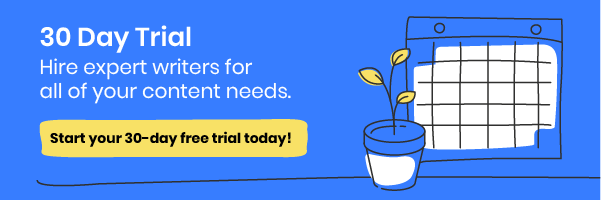- Blog Home
- Seo
- Ciara Antolini
- How To Track And Measure Seo Success
How to Track and Measure SEO Success
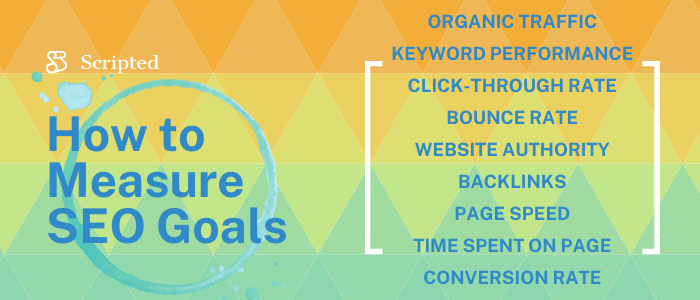
In the dynamic landscape of digital marketing, the old adage holds true: “You can’t manage what you don’t measure.” Marketers who set specific goals, establish clear success indicators, and employ a data-driven approach to analysis and decision-making outperform their peers. A measured, analytical approach in marketing saves you the trouble of flying blind and uncovers pathways to insights about your audience and more conversions.
In the world of search, understanding your data is more crucial than ever. Search engines are still one of the most relevant, complex, and competitive online spaces for businesses today and they demand a thorough approach. SEO, or Search Engine Optimization, isn’t just about clinching the top spot on Search Engine Results Pages (SERPs). It encompasses a deep understanding of user engagement, website health, brand authority, and an array of vital Key Performance Indicators (KPIs). Given SEO's significance and complexity, marketers must dedicate time and effort to grasp its nuances.
Google’s algorithm considers over 200 ranking factors, ranging from technical site architecture to user experience. However, amidst these factors, there is a subset of metrics crucial for all businesses to monitor regularly. Tracking these metrics enables organizations to make informed, data-driven decisions that can significantly enhance their digital presence, ensuring their website not only captures the attention of search engines but also provides a superior user experience.
In this guide, we’ll dive into the essential metrics you need to monitor for SEO success. With insights on how to elevate performance levels, from boosting engagement to fortifying website authority, you'll also get a glimpse of how AI is reshaping the way we optimize for search.
Understanding Key SEO Metrics
Embarking on your SEO journey for the first time feels like navigating uncharted territory. Without a guide, it can be hard to pinpoint the exact position of your brand in the digital landscape. While there are numerous metrics to watch, there are three beacon-like metrics that provide businesses with a clear picture of their digital footprint: organic traffic, keyword performance, and click-through rate (CTR).
Organic Traffic

Organic traffic refers to the number of users who find and visit your website through unpaid sources, including unpaid search engine results, direct browser entries, referral links from other websites, and unpaid social media shares. In SEO, organic traffic is valued for its authenticity, as it comes from users actively seeking information or services that your website offers, without the influence of paid advertising. In analytics, you might see organic traffic quantified as ‘2,400 unique visits this week’ or ‘328 unique visits as of today.’ Because it directly represents how many clicks your site is getting, it’s a key marker of how effective your SEO strategy is.
You don’t need to stop at the simple number of visitors, though! It’s best practice to get granular with your data to uncover richer insights about your site, content, and audience. Here are some ideas for how to discover more from your organic traffic:
- Find Your Best Keywords: Uncover the words and phrases that naturally bring visitors to your site through search engines. Optimize your content around these terms to boost organic traffic.
- Identify Your Most-Visited Pages: Determine which pages on your site attract the most organic visitors. Analyze these pages to understand what works and apply those insights across your site.
- Track Organic Backlinks: Inbound links from other sites can significantly impact your search engine rankings. Track who is linking to you to understand which links contribute positively to your organic traffic.
- Keep Your Site Error-Free: Errors on your site can harm your search engine rankings and lead to a loss of organic traffic. Regularly monitor and fix any issues to ensure a steady flow of organic visitors.
Keyword Performance

Keyword performance is how well your website ranks for targeted short- and long-tail keywords in search. Short-tail keywords typically consist of one to three words, while long-tail keywords are phases generally made up of three to five words. Both are crucial components of your Search Engine Optimization (SEO) and Search Engine Marketing (SEM) strategies. Regularly monitoring your keyword performance ensures that your business has a clear understanding of your positioning in relation to the terms you’re targeting.
While you can manually check your position on the SERPs by entering a keyword, you can take a more systematic approach by using a keyword tool. Scripted offers several options for leveling up your SEO stack. Our Keyword Research Tool allows you to analyze your target keywords and suggests related ones for you to target, as well. With our tool, you can track search volume, competition, cost per click, and how difficult it is to rank for certain keywords and phrases.
Another method for tracking keyword performance is doing a keyword gap analysis. This is the process of identifying keywords your competitors are targeting in their keyword strategy, while you aren’t. Scripted users get exclusive access to our URL Analyzer, which allows you to enter any URL and get a detailed report on how target keywords are used throughout and suggestions for improvement. You can use the tool to evaluate URLs on your own site or directly compare them against competitor pages to identify areas for improvement or get ideas for which keywords you’ve been neglecting.
In 2024, marketers should also be considering how they can use AI to make sense of their performance data and supercharge their keyword research and targeting strategies. Scripted’s suite of AI tools can also help you generate SEO-optimized headlines, work through your SEO strategy, and even get relevant blog ideas for your business. Explore our tools today to future-proof your SEO efforts!
Click-Through Rate (CTR)
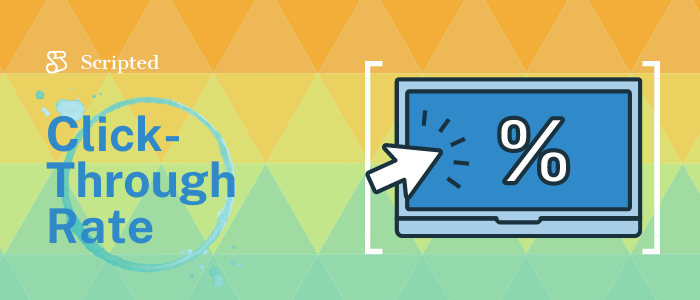
Your click-through rate (CTR) is pivotal to understanding the efficacy of your online content, particularly the meta title and meta description that appear in SERPs. In essence, CTR is the percentage of users who click on your link compared to the number of total users who view your link (impressions). For instance, if your website appeared 1,000 times last week and 270 people clicked, your CTR would be 27%.
What does your CTR mean for your business? A high CTR suggests that your content snippets are engaging. Moreover, a good CTR is key for maximizing potential organic traffic from your SEO efforts. Finally, monitoring CTR can alert you to shifts in content relevance, prompting timely updates. AI can help you optimize around such shifts, developing suggestions for new and more relevant copy and even developing A/B testing around your meta content.
Engagement Metrics in SEO
The next group of SEO metrics we’ll delve into are related to users’ engagement with your content. Engagement metrics like bounce rate, time spent on the page, and conversion rate give you clear insights into what your audience finds useful and interesting, what on-site messaging inspires them, and what compels them to enter your sales funnel.
Bounce Rate
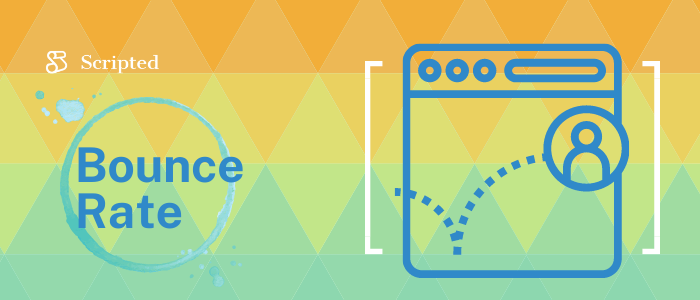
Your website's bounce rate quantifies the percentage of visitors who exit after viewing just one page on your website. This metric is typically quantified by a percentage, so if your bounce rate is 30%, that means three out of 10 visitors exit from your site without further exploration.
A high bounce rate is bad news because search engines assume bouncing visitors aren’t getting the answers they want from your site. However, interpreting bounce rate requires nuance as it can be influenced by:
-
Irrelevant Content: The information on the landing page might not meet user expectations.
-
Suboptimal UX: Factors like slow loading times, poor design, or complex navigation can deter exploration.
-
Satisfactory Content: Ironically, a visitor might leave because they found exactly what they needed quickly, rendering further browsing unnecessary.
To address a high bounce rate, you’ll need to investigate to determine which of these is your root cause. Dig into user behavior data to find out which pages users are bouncing from and which pages are inspiring them to stay. Audit copy, the order of information, design, imagery, and load times, identifying opportunity areas.
A huge part of an SEO’s job is to test, learn, and optimize. This continuous improvement process creates a perfect opportunity for integrating AI. AI can play a pivotal role in designing A/B tests for elements such as headlines and layouts, thereby accelerating the evolution of your website and enriching the overall user experience.
AI tools like Scripted Copilot, which can swiftly analyze your content and offer actionable improvement suggestions within minutes, can be a game-changer for your SEO strategy, so if you're ready to supercharge your SEO efforts, sign up for a Scripted account today.
Time Spent on Page

The average time a visitor spends on a page can provide vital insights about your site. As marketers, more time spent on a page often indicates that users are not only consuming information but also engaging with your products or services.
Analyzing time spent on a page allows you to pinpoint where visitors find value and potentially identify issues with your site's user experience. For instance, a user investing minutes in your latest blog post might be deepening their connection with your brand, while another spending considerable time on your checkout page could be price-comparing or experiencing buyer's remorse. This metric provides a nuanced view of visitor experiences.
To gain further insights into visitor behavior, consider investing in a heatmap tool. These tools reveal the average cursor movements and lingering points, shedding light on which content users are reading, which CTAs capture their attention, and even which sections they consistently bypass.
Most marketers will be focused on getting users to spend more time on their websites rather than less. You can increase time spent on your site through a strong content marketing strategy, delivering valuable tools and resources, and presenting outstanding products or services.
Conversion Rate
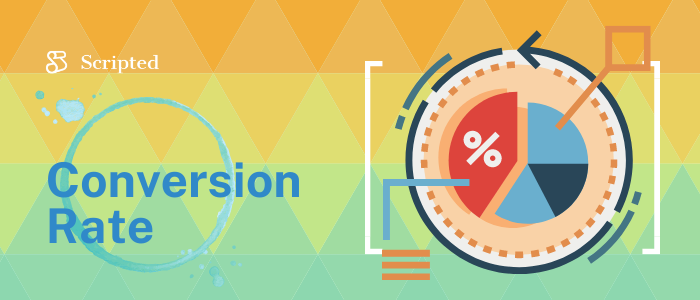
Conversions are one of the most important metrics by which to measure your marketing efforts. Your conversion rate is the percentage of visitors who buy a product or become a lead in your funnel. For example, if your site gets 1,000 visitors and 15 of them register to get your new lead magnet, you have a conversion rate of 1.5%
Adoric suggests that a good conversion rate falls somewhere between two and five percent. However, depending on factors like your niche, average sales cycle, or closing time, what constitutes a “good” rate may vary.
If you’re not sure how your conversion rate stacks up against industry standards, benchmarking is a great place to start. If you find that after comparing your conversions and revenue against your goals, there’s room for improvement, consider evaluating areas such as:
-
Poor Calls-to-Action: Ensure your CTAs are compelling and direct users toward the desired action.
-
Unpersuasive Content: Content should resonate with your target audience and drive them toward conversion.
-
Keywords: Are you targeting the right keywords that align with user intent and your offerings?
Working backward through your strategy can help you pinpoint where metrics might be lagging and give you ideas for what to improve.
Assessing Website Health and Authority
Finally, there are a few metrics that measure your website’s health and authority. Domain authority, while it doesn’t factor into your SERP ranking, is a key indicator of the performance of your website compared to others in your industry. On the other hand, metrics like backlinks and site speed are factored into your position in the SERPs. Learn more about these metrics in the sections below.
Backlinks

Backlinks are inbound links from other websites that demonstrate your site’s authority and represent votes of confidence from other sources. These links are a critical factor in search engine ranking algorithms and as a result, more quality backlinks equal higher visibility in search results.
Regularly assessing your backlink profile is crucial. A backlink monitoring tool can help you track all of your backlinks on a single platform, identify high- and low-quality backlinks, and even track your competitors’ links, too. You can use backlink insights to establish outreach campaigns toward high-quality websites in your industry, aiming to secure more quality backlinks in the future.
By actively managing and optimizing your backlink profile, you can enhance your website's authority and visibility in search engine results, ultimately strengthening your SEO efforts.
Domain Authority
While not a direct determinant of your SERP ranking, domain authority (DA) indicates how your website stacks up against your competitors. This metric considers various factors like the quality and quantity of backlinks, overall website performance, and content relevance. Authority is quantified on a scale from 1 to 100, with higher scores signifying stronger authority. A high DA suggests that your website is a respected source of information within your niche.
The key to increasing your website authority is to produce high-quality content while optimizing on-page SEO. From a content marketing perspective, you should focus on acquiring authoritative backlinks, maintaining a strong social presence that drives traffic to your site and promotes sharing, and driving content development around the right keywords and trends. From an SEO perspective, auditing and eliminating old backlinks and maintaining a technically strong site on desktop and mobile can go a long way. Increasing domain authority is a long game, only persistence, patience and a strong content marketing and SEO strategy will win the race.
Page Speed

In today’s digital age, website speed plays an important role in both user experience and SEO. Site speed refers to how quickly your pages load and display content to visitors. While it may seem superficial, page speed isn’t just a matter of convenience, it’s a crucial factor that can directly impact your search rankings and even your conversions
Hubspot rounded up some data on the impact of page speed on metrics such as conversion and bounce rate. One of the most shocking takeaways was that the first five seconds of load time have an outsized impact on your conversion rate. Google also considers site speed as a ranking factor, which means that faster-loading websites are more likely to rank higher in search results. The bottom line? Visitors are more likely to abandon a slow-loading site in favor of a faster alternative.
To ensure a seamless user experience and maintain a competitive edge, you need to optimize your website's speed. This might mean optimizing images and multimedia, reducing unnecessary code and scripts, leveraging browser caching, and choosing a reliable web hosting provider.
How AI Can Supercharge Your SEO Efforts
To achieve your SEO goals, a strong SEO/SEM strategy and persistence are essential. In the dynamic world of digital marketing, harnessing the power of AI can provide a significant advantage. AI contributes significantly to three critical aspects of your content marketing and SEO strategy:
Using AI for SEO Analysis and Insights
In the digital age, data reigns supreme, and AI is your key to unlocking its full potential. AI-driven data analysis goes beyond surface-level statistics. It has the power to delve deep into large datasets, extracting valuable insights and revealing intricate patterns that might remain hidden from human analysis. When it comes to surveying your SEO landscape, AI can offer a powerful lens through which to look at it. Some examples of how AI can advance your SEO analytics are:
-
Analyzing user behavior patterns to recommend personalized content.
-
Predicting the most effective keywords for better search visibility.
-
Summarizing complex data into actionable insights for informed decision-making.
Using AI for SEO Strategy and Test Development
Your SEO strategy is the compass that guides your journey to digital success. Whether you’re new to SEO or experienced at driving leads to your site, AI can be a strong strategic partner on that journey. Some examples of how AI can help you out on strategy are:
-
Developing an SEO strategy from scratch, including a roadmap, best practices, and targeted objectives to align with your business goals.
-
Recommending strategic site and content optimizations based on data analysis.
-
Generating A/B test ideas for headlines to improve click-through rates.
-
Adapting strategies quickly to evolving search algorithms, keeping your approach competitive.
Using AI for Content Development and Keyword Research
Content is the heart of SEO, and AI can take it to a whole new level. With AI tools can write and remix copy faster than a human being, allowing you to churn out copy at a faster rate, increasing your crawl rate, building domain authority, and boosting brand visibility. Ai can improve your content strategy by:
-
Generating SEO-optimized content suggestions for various topics.
-
Developing detailed outlines for blog posts.
-
Identifying high-conversion keywords that outperform competitors.
-
Automating content creation, ensuring consistent and engaging content delivery for landing pages, FAQs, and more.
Incorporating AI into your SEO strategy simplifies data analysis, optimizes strategies, and automates content creation, driving sustained organic growth.
What are the limitations of AI in Content and SEO?
AI has come a long way since its inception. GPT-4, the language model released by OpenAI this year, has demonstrated the most advanced natural language processing capabilities yet. It has proven its ability to generate complex, relevant, and remarkably human-like text across a variety of subjects, contents, and styles. As a result of these AI advancements, there are more artificial intelligence-powered content creation tools on the market than ever before, including our prompt-free tool, Scripted Copilot.
Marketers want to know whether these tools can compare to human writers and content strategists, and if so, where their limitations are.
Can AI Content Compare to Human Content?
While AI tools are highly talented at strategic and analytical tasks, marketers are still learning how much you should rely on AI for content development. Some marketers are waiting to implement these sorts of tools into their content workflows. Other experts in the field are dicing right into AI content creation, advancing the theory that while Google can detect AI content writing, its helpful content update aims to advance good content no matter who (or what!) produced it.
But is AI good enough to produce SEO content? We recently covered an SEO experiment where a group of marketers compared human and AI copywriting. The team produced 10 articles based on a made up keyword, five penned by a person and the other five by ChatGPT. The team published the articles on previously created sites and then used keyword position tracking to see how they ranked on the SERPs over time. Surprisingly, the human content consistently outranked the AI-generated content, indicating a search engine preference for human content.
Based on these results, the best approach to using AI for content creation might be to implement AI tools more heavily for strategy than content development. While AI tools can help you generate great ideas and produce high-quality text for social media, landing pages, press releases,, and other templated content types, you might be better off using human copywriters for SEO content.
Achieving Your SEO Goals with Reporting and AI
In the world of SEO, marketers need to set clear goals, make consistent progress, and track their progress as they go. Success doesn’t come overnight—it hinges on a combination of strategic prowess, data-driven insights, and dynamic content creation over time. Think of the nine metrics we covered as the signs pointing you to your final destination.
With AI-driven tools and a commitment to continuous improvement, you have the means to achieve SEO success.
Get Started with Scripted
Don't navigate your SEO journey alone. Sign up for a Scripted account today and harness our unique blend of AI-powered marketing tools and human content pros.
We’re the only content service on the market that can give you access to AI-powered tools like our headline and blog idea generator alongside guidance from expert content professionals who can guide your strategy development, plan your keyword strategy, and write top-quality content that ranks. With Scripted, you’ll have everything you need to enhance your website's authority, boost visibility, and achieve success in the digital landscape.
